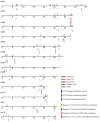Comparative transcriptional profiling of three super-hybrid rice combinations
- PMID: 24595241
- PMCID: PMC3975368
- DOI: 10.3390/ijms15033799
Comparative transcriptional profiling of three super-hybrid rice combinations
Abstract
Utilization of heterosis has significantly increased rice yields. However, its mechanism remains unclear. In this study, comparative transcriptional profiles of three super-hybrid rice combinations, LY2163, LY2186 and LYP9, at the flowering and filling stages, were created using rice whole-genome oligonucleotide microarray. The LY2163, LY2186 and LYP9 hybrids yielded 1193, 1630 and 1046 differentially expressed genes (DGs), accounting for 3.2%, 4.4% and 2.8% of the total number of genes (36,926), respectively, after using the z-test (p < 0.01). Functional category analysis showed that the DGs in each hybrid combination were mainly classified into the carbohydrate metabolism and energy metabolism categories. Further analysis of the metabolic pathways showed that DGs were significantly enriched in the carbon fixation pathway (p < 0.01) for all three combinations. Over 80% of the DGs were located in rice quantitative trait loci (QTLs) of the Gramene database, of which more than 90% were located in the yield related QTLs in all three combinations, which suggested that there was a correlation between DGs and rice heterosis. Pathway Studio analysis showed the presence of DGs in the circadian regulatory network of all three hybrid combinations, which suggested that the circadian clock had a role in rice heterosis. Our results provide information that can help to elucidate the molecular mechanism underlying rice heterosis.
Figures






Similar articles
-
Comparative transcriptional profiling and preliminary study on heterosis mechanism of super-hybrid rice.Mol Plant. 2010 Nov;3(6):1012-25. doi: 10.1093/mp/ssq046. Epub 2010 Aug 20. Mol Plant. 2010. PMID: 20729474 Free PMC article.
-
Comparative proteomic study reveals dynamic proteome changes between superhybrid rice LYP9 and its parents at different developmental stages.J Plant Physiol. 2012 Mar 1;169(4):387-98. doi: 10.1016/j.jplph.2011.11.016. Epub 2011 Dec 29. J Plant Physiol. 2012. PMID: 22209166
-
Integrated analysis of phenome, genome, and transcriptome of hybrid rice uncovered multiple heterosis-related loci for yield increase.Proc Natl Acad Sci U S A. 2016 Oct 11;113(41):E6026-E6035. doi: 10.1073/pnas.1610115113. Epub 2016 Sep 23. Proc Natl Acad Sci U S A. 2016. PMID: 27663737 Free PMC article.
-
Heterosis in elite hybrid rice: speculation on the genetic and biochemical mechanisms.Curr Opin Plant Biol. 2013 May;16(2):221-7. doi: 10.1016/j.pbi.2013.03.009. Epub 2013 Apr 13. Curr Opin Plant Biol. 2013. PMID: 23587937 Review.
-
Genetic and molecular mechanisms of reproductive isolation in the utilization of heterosis for breeding hybrid rice.J Genet Genomics. 2024 Jun;51(6):583-593. doi: 10.1016/j.jgg.2024.01.007. Epub 2024 Feb 5. J Genet Genomics. 2024. PMID: 38325701 Review.
Cited by
-
Co-expression network analysis reveals transcription factors associated to cell wall biosynthesis in sugarcane.Plant Mol Biol. 2016 May;91(1-2):15-35. doi: 10.1007/s11103-016-0434-2. Epub 2016 Jan 28. Plant Mol Biol. 2016. PMID: 26820137 Free PMC article.
-
Hormone-regulated defense and stress response networks contribute to heterosis in Arabidopsis F1 hybrids.Proc Natl Acad Sci U S A. 2015 Nov 17;112(46):E6397-406. doi: 10.1073/pnas.1519926112. Epub 2015 Nov 2. Proc Natl Acad Sci U S A. 2015. PMID: 26527659 Free PMC article.
References
-
- Melchinger A.E., Gumber R.K. Overview of Heterosis and Heterotic Groups in Agronomic Crops. In: Lamkey K.R., Staub J.E., editors. Concepts and Breeding of Heterosis in Crop Plants. Crop Science Society of America; Madison, WI, USA: 1998. pp. 29–44.
-
- Zhang L., Peng Y., Dong Y., Li H., Wang W., Zhu Z. Progress of Genomics and Heterosis Studies in Hybrid Rice. In: Chen Z.J., Birchler J.A., editors. Polyploid and Hybrid Genomics. John Wiley & Sons, Inc.; Oxford, UK: 2013. pp. 117–135.
Publication types
MeSH terms
Substances
LinkOut - more resources
Full Text Sources
Other Literature Sources

